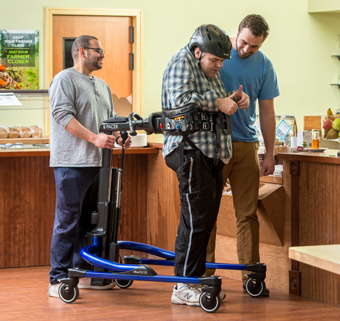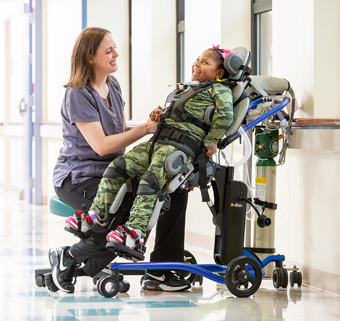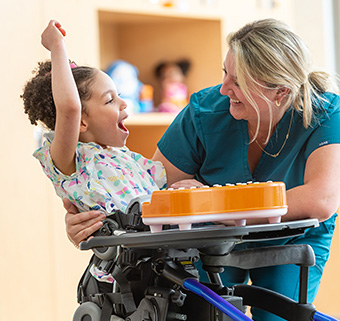The Clinical Progression
Moving From the Treadmill to Overground Ambulation in Rehab
| November 2016 Gait training is central in the rehabilitation of individuals with neuromotor disabilities. In clinical circles, there is considerable debate over whether gait and balance training is best performed over a treadmill or over ground. Is one intervention more effective than the other? The research on this topic is inconclusive at best. What we do know, however, is that studies comparing the two gait training progression approaches show that both yield good outcomes. So when and why would you choose one over the other, or is there a place for both?
Gait training is central in the rehabilitation of individuals with neuromotor disabilities. In clinical circles, there is considerable debate over whether gait and balance training is best performed over a treadmill or over ground. Is one intervention more effective than the other? The research on this topic is inconclusive at best. What we do know, however, is that studies comparing the two gait training progression approaches show that both yield good outcomes. So when and why would you choose one over the other, or is there a place for both?
I like to explore this by drawing from a variety of clinical resources – current knowledge of the principles of motor learning and neuroplasticity, the available research and clinical expertise. Each adds a valuable perspective.
Motor Learning and Neuroplasticity
Motor learning and neuroplasticity are the overarching guides to almost any therapy intervention. Our current understanding of motor learning, especially in children, is based on dynamic systems theory (DST), referred to in practice as the “task-oriented approach.”1,2,3 This approach recognizes the importance of both the task and the environment in the creation of efficient motor solutions. It also recognizes that we learn best when we work on skills that relate directly to a daily activity or a task that interests us or motivates us.
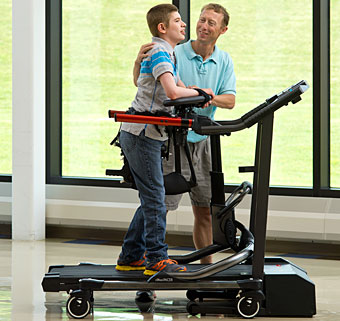 The amount of skill practice is of paramount importance.4,5,6 Schmidt and Lee, who are leaders in the field of neuro-rehabilitation, emphasize what is often taken for granted: “Clearly, more learning will occur if there are more practice trials. Perhaps we do not need to say any more about the amount of practice than this: In structuring the practice session, the number of practice attempts should be maximized.”4 In the world of motor learning and function-based programs we speak of 2,000 practice trials in order to learn a new skill.8
The amount of skill practice is of paramount importance.4,5,6 Schmidt and Lee, who are leaders in the field of neuro-rehabilitation, emphasize what is often taken for granted: “Clearly, more learning will occur if there are more practice trials. Perhaps we do not need to say any more about the amount of practice than this: In structuring the practice session, the number of practice attempts should be maximized.”4 In the world of motor learning and function-based programs we speak of 2,000 practice trials in order to learn a new skill.8
Learning through practice is also the main way known to science of stimulating neuroplastic changes or reorganizing the remaining healthy tissue in a damaged brain. In their paper, Kleim and Jones describe ten principles of experience-dependent neural plasticity that, when applied in practice sessions, help to guide the formation of new neural connections in the brain. These principles emphasize the importance of continued, intense use of the neural circuitry and task-specific and repetitive skill practice.9
Clearly, providing intervention that is true to the principles of DST is essential. So when we think about the best approach to progressive ambulation and gait training we must consider how to provide the best environment for motor learning and neuroplasticity to take place. With these principles in mind, let's examine how treadmill gait training creates optimal conditions for neuroplastic change.
Treadmill Gait Training
The clinical environments for gait training are either on the treadmill or over the ground. An understanding of what each entails is necessary for making the clinical decisions necessary to guide successful gait training.
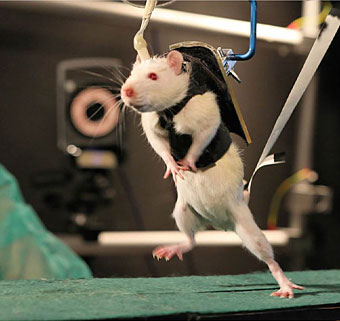 The idea for using a treadmill to regain ambulation abilities started with research in animal models. Here researchers noted that after months of practice, cats and rats with severed spinal cords were able to take steps with their hind limbs on a treadmill if their hindquarters were supported.10 This animal research laid the groundwork for human gait training progression protocols. Manipulating the intraspinal circuits of cats and rats with repetitive, treadmill driven stepping has since provided a foundation for approaching human gait recovery.11,12,13,14,15
The idea for using a treadmill to regain ambulation abilities started with research in animal models. Here researchers noted that after months of practice, cats and rats with severed spinal cords were able to take steps with their hind limbs on a treadmill if their hindquarters were supported.10 This animal research laid the groundwork for human gait training progression protocols. Manipulating the intraspinal circuits of cats and rats with repetitive, treadmill driven stepping has since provided a foundation for approaching human gait recovery.11,12,13,14,15
As with the cat and rat models, body-weight support (BWS) is essential in gait rehabilitation, especially over a treadmill. An individual at the start of gait training is debilitated with weakness, poor coordination and balance issues. In conventional rehab without BWS, these factors contribute to fatigue and fear of falling, therefore limiting the length of the practice session. But harnesses, slings and saddles that support an individual’s weight bearing change this dramatically. By decreasing the load through the lower extremities there is less fatigue and fear of falling which allows longer, more intense practice sessions as well as an earlier start at rehab for individuals with significant disabilities. These weight shifts with partial body weight support allow individuals to focus on movement quality rather than stability alone.
Partial body weight support also gives the individual a chance to concentrate on stepping and less on balance and weight-bearing. Furthermore, BWS allows the clinician to step away and focus on guiding a typical gait pattern, reciprocal arm swing and trunk mobility.
Combine BWS with the treadmill and you now have what clinicians recognize as a safe and structured walking environment. The treadmill belt drives the gait cycle affording a high degree of energy-efficient gait repetition and re-patterning work. A patient supported on the treadmill is able to take more steps in the same amount of time and achieve a higher walking velocity compared to over-ground walking. This provides the practice and intensity needed for neuroplastic changes early on in recovery.12,16,17,18,19,20
Treadmill gait training also improves mobility and gives therapists measurable ways to track progress, such as increases in step length, cadence, and symmetry. By focusing on repetition in a safe environment, treadmill-based progressive ambulation helps restore confidence and contributes significantly to overall quality of life for individuals recovering from neurological conditions.
Research supports this approach for early-stage rehabilitation. Treadmill training then seems most appropriate for those in the acute and early stages of rehab. Research demonstrates that non-ambulatory individuals, or those with more involved impairments, perform better on a treadmill as opposed to supported over-ground walking.21,22,23,24 McCain, looking at a group of adults post-stroke concludes: “The application of locomotor treadmill training with partial body weight support before over-ground gait training may be more effective in establishing symmetric and efficient gait in acute rehabilitation.”25
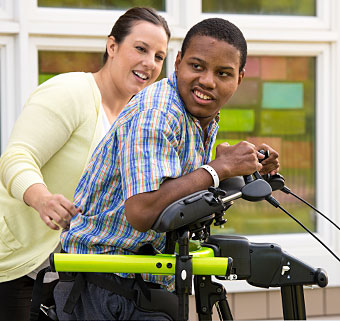 Over-ground Gait Training
Over-ground Gait Training
What then is the role of over-ground gait training? Over-ground gait training involves negotiating an actual environment—rooms, hallways, paths and parks. Stepping is self-generated requiring muscle activation to drive ground-reaction forces and the weight-shifting of limbs resulting in better gait kinematics and functional walking speeds.26,27,28
This is perfect for individuals in the later stages of rehab who can walk or who have impairments that are less severe. For these people, over-ground gait training is a way to continue motor learning opportunities that are challenging, intense, problem-solving and task-specific in the clinic. It is also a chance to work on balance, postural control and community navigation—opportunities not afforded by treadmill practice.29,30,31
Functional Benefits and Real-World Application
Overground gait training is especially valuable for practicing transitions, such as moving from sitting to standing or stopping and starting in real environments. It also allows therapists to integrate assistive devices, such as walkers, canes, or gait trainers, into treatment plans. These tools not only support safety but also help increase step length, encourage proper weight bearing, and improve balance. Overground walking in natural settings—parks, sidewalks, or homes—provides variety and fosters problem-solving that directly translates into independence and improved quality of life.
Clinical Progression
A clinical progression is perhaps the best way to describe the complementary nature of treadmill and over-ground gait training. As we know from motor learning theory and research, gait interventions for people with neurological disabilities should be task-specific and challenging with frequent practice opportunities. As an individual’s capabilities improve, moving from the supported treadmill to over-ground walking provides a perfect way to maintain the level of intensity and practice that motor learning requires.12,27,32 The following sequence optimizes both treadmill gait training and overground gait training:
- Body-weight supported treadmill gait training for practice re-patterning gait and improving neuromuscular capabilities.
- Over-ground walking in a clinical environment with over-ground assistive devices to encourage client-initiated movement.
- Integrating over-ground gait training skills into actual task-specific environments such as the home and community. This involves negotiating various environments, changing walking pace and stopping and starting.
Clinical Progression Case Studies
These progressions aren't just theoretical—they transform lives, as the following cases demonstrate. An individual with traumatic brain injury (TBI) and an individual with cerebral palsy (CP) provide great illustrations of this clinical progression in gait rehabilitation.
Sean Carter
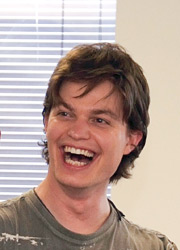
Sean was a teenager when he sustained a TBI from a drunk-driving accident. This left him paralyzed and unable to walk. After four years in a wheelchair he began an aggressive program of gait training. In this short video clip his therapist, Dr. Karen McCain, tells Sean’s recovery story and how he progressed, with intense practice, from the treadmill to over-ground gait training in the clinic. She particularly emphasizes the importance of supported over-ground practice for gait recovery.
In this next video, we can see Sean ambulating over-ground outdoors. It is amazing to see the progress he made with rehabilitation applying the principles of motor learning and neuroplasticity.
Payton White
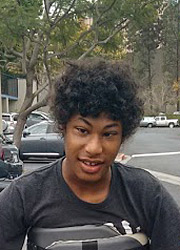
Payton has a diagnosis of cerebral palsy and initially presented with limited ambulation ability from lower extremity rotational deformities, contractures and spasticity. On first coming to VIP Rehab, a private practice offering intensive 3-hour daily sessions, Payton walked in the Lokomat, a robotic treadmill, for 30 minutes. His therapist, Donna Nasielski, PT noted that the treadmill provided Payton with much needed intense stepping repetition, weight-bearing through the lower extremities and his upright posture improved circulation. Because of Payton’s increased spasticity it was difficult for him to take steps, so the Lokomat was good because it kept him walking. This video clip shows Payton working on stepping in the Lokomat:
After the Lokomat, Payton transferred to the Rifton Pacer, an assistive gait device, for over-ground ambulation. As a result, his hip flexion contractures stretched out and he increased his step length from 3 inches to 10–11 inches. The Pacer’s saddle additionally provided enough separation for his legs that scissoring was no longer an issue.
Now Payton is working on side stepping and walking outdoors using the momentum from a slight downhill ramp seen here:
Conclusion
Demonstrated by the case studies and supported by research, the progression from partial body weight support on the treadmill to over-ground gait training is a successful gait rehabilitation approach for individuals with neuromotor disabilities. Through considering the research findings and the premises of motor learning and neuroplasticity, treadmill gait training and over-ground gait training are combined effectively. The work on the treadmill gives an individual the opportunity to learn (re-learn) reciprocal stepping patterns in the acute phases of recovery and disability. The positioning offered by the various body-weight support devices contributes to longer practice sessions and optimal environments for motor learning to take place. As the individual improves, supported over-ground ambulation continues the learning process with increasingly challenging and task-specific environments.
Ultimately, this blend of treadmill gait training, overground gait training, and progressive ambulation improves mobility, enhances independence, and contributes directly to a better quality of life for patients. By using step length, weight shifts, and assistive devices as key measures of progress, clinicians can tailor therapy that restores not only walking ability but also confidence and community participation.
References
1. Thomson G. Children with Severe Disabilities and the MOVE Curriculum: Foundations of a Task Oriented Approach. 2005; Chester NY: East River Press.
2. Smith LB, Thelen E. A Dynamic Systems Approach to Development: Applications. 1993; Cambridge, MA: The MIT Press / Bradford Books.
3. Thelen E. The (re)discovery of motor development: Learning new things from an old field. Dev Psychol. 1989;25(6):946-49.
4. Schmidt RA, Lee TD. Motor Control and Learning: A Behavioral Emphasis. 2005, 4th ed. Champaign, IL: Human Kinetics.
5. Carr and Shepherd. A Motor Learning Model for Rehabilitation. Movement Science. 1987; Aspen Publishers.
6. Carr and Shepherd. Neurological Rehabilitation: Optimizing Motor Performance. 2011; Churchhill Livingstone.
8. Bidabe DL. Mobility Opportunities Via Education: A curriculum written to serve children and adults with severe disabilities. 2003, 7th printing. Bakersfield: Kern County Superintendent of Schools.
9. Kleim JA, Jones TA. Principles of experience-dependent neural plasticity: implications for rehabilitation after brain damage. J Speech Lang Hear Res. 2008; 51(1): S225-39.
10. Barbeau H, Rossignol S. Recovery of locomotion after chronic spinalization in the adult cat. Brain Res. 1987; 412(1):84-95.
11. Bailes A, Sanese K, Schmit J. Cincinnati Children’s Hospital Medical Center: Intensive Partial Body Weight Supported Treadmill Training, Occupational Therapy and Physical Therapy Evidence-Based Care Guidelines, Cincinnati Children’s Hospital Medical Center. BESt 072, pages 1-10, October 2010.
12. Aurich T, Warken B, Graser J, Ulrich T, Borggraefe I et al. Practical recommendations for robot-assisted treadmill therapy (Lokomat) in children with cerebral palsy: Indications, goal setting, and clinical implementation within the WHO-ICF framework. Neuropediatrics. 2015;46:248-60.
13. MacKay-Lyons M. Central pattern generation of locomotion: a review of the evidence. Phys Ther. 2002;82:69-83.
14. Dimitrijevic M, Gerasimenko Y, Pinter M. Evidence for a spinal central pattern generator in humans. Ann NY Acad Sci.1998;860:360-76.
15. Barbeau H, Visintin M. Optimal outcomes obtained with body weight support combined with treadmill training in stroke subjects. Arch Phys Med Rehabil. 2003;84:1458-65.
16. Duncan P, Sullivan K, Behrman A, et al. Body-weight-supported treadmill rehabilitation after stroke. N Engl J Med. 2011;364:2026-36.
17. Ulrich D, Lloyd M, Tiernan C, et al. Effects of intensity of treadmill training on developmental outcomes and stepping in infants with Down syndrome. Phys Ther. 2008;88:114-22.
18. Damiano D, DeJong S. A systematic review of the effectiveness of treadmill training and body weight support in pediatric rehabilitation. J Neurol Phys Ther. 2009;33(1):27-44.
19. Mattern-Baxter K. Effects of partial body weight supported treadmill training on children with cerebral palsy. Pediatr Phys Ther. 2009;21(1):12-22.
20. McNevin N, Coraci L, Schafer J. Gait in adolescent cerebral palsy: The effect of partial unweighting. Arch Phys Med Rehabil. 2000;81:525-28.
21. Ada L, Dean C, Morris M, Simpson J, Katrak P. Randomized trial of treadmill walking with body weight support to establish walking in subacute stroke: the MOBILISE trial. Stroke. 2010; 41(6):1237-42.
22. DiBlasio P, Lewis C. Exercise training utilizing body weight-supported treadmill walking with a young adult with cerebral palsy who was non-ambulatory. Physiotherapy Theory and Practice. 2012;28(8):641-52.
23. Su I, Chung K, Chow D. Treadmill training with partial body weight support compared with conventional gait training for low-functioning children and adolescents with nonspastic cerebral palsy: A two-period crossover study. Prosthet Orthot Int. 2016;37(6):445-53.
24. Cherng R-J, Liu C-F, Lau T-W, Hong R-B. Effect of treadmill training with body weight support on gait and gross motor function in children with spastic cerebral palsy. Am J Phys Med Rehabil. 2007;86(7):548-55.
25. McCain KJ, Pollo FE, Baum BS, Coleman SC, Baker S, Smith PS. Locomotor treadmill training with partial body-weight support before overground gait in adults with acute stroke: a pilot study. Arch Phys Med Rehabil. 2008;89(4):684-691.
26. Jung T, Kim Y, Kelly L, Abel M. Biomechanical and perceived differences between overground and treadmill walking in children with cerebral palsy. Gait Posture. 2016;45:1-6.
27. Celestino M, Gama G, Longuinho G, Fugita M, Barela A. Influence of body weight unloading and support surface during walking of children with cerebral palsy. Fisioter Mov. 2014;27(4):591-9.
28. Rose J, Gamble J, Burgos A, et al. Energy expenditure index of walking for normal children and for children with cerebral palsy. Dev Med Child Neurol. 1990;32:333-340.
29. Macko R, Ivey F, Forrester L, et al. Treadmill exercise rehabilitation improves ambulatory function and cardiovascular fitness in patients with chronic stroke: a randomized, controlled trial. Stroke. 2005;36(10):2206-11.
30. Macko R, Benvenuti F, Stanhope S, Macellari V, Taviani A et al. Adaptive physical activity improves mobility function and quality of life in chronic hemiparesis. J Rehabil Res Dev. 2008;45(2):323-28.
31. Provost B, Dieruf K, Burtner P, et al. Endurance and gait in children with cerebral palsy after intensive body weight-supported treadmill training. Pediatr Phys Ther. 2007;19:2-10.
32. Willoughby K, Dodd K, Shields N, Foley S. Efficacy of partial body weight–supported treadmill training compared with overground walking practice for children with cerebral palsy: A randomized controlled trial. Arch Phys Med Rehabil. 2010;91(3):333-39.

